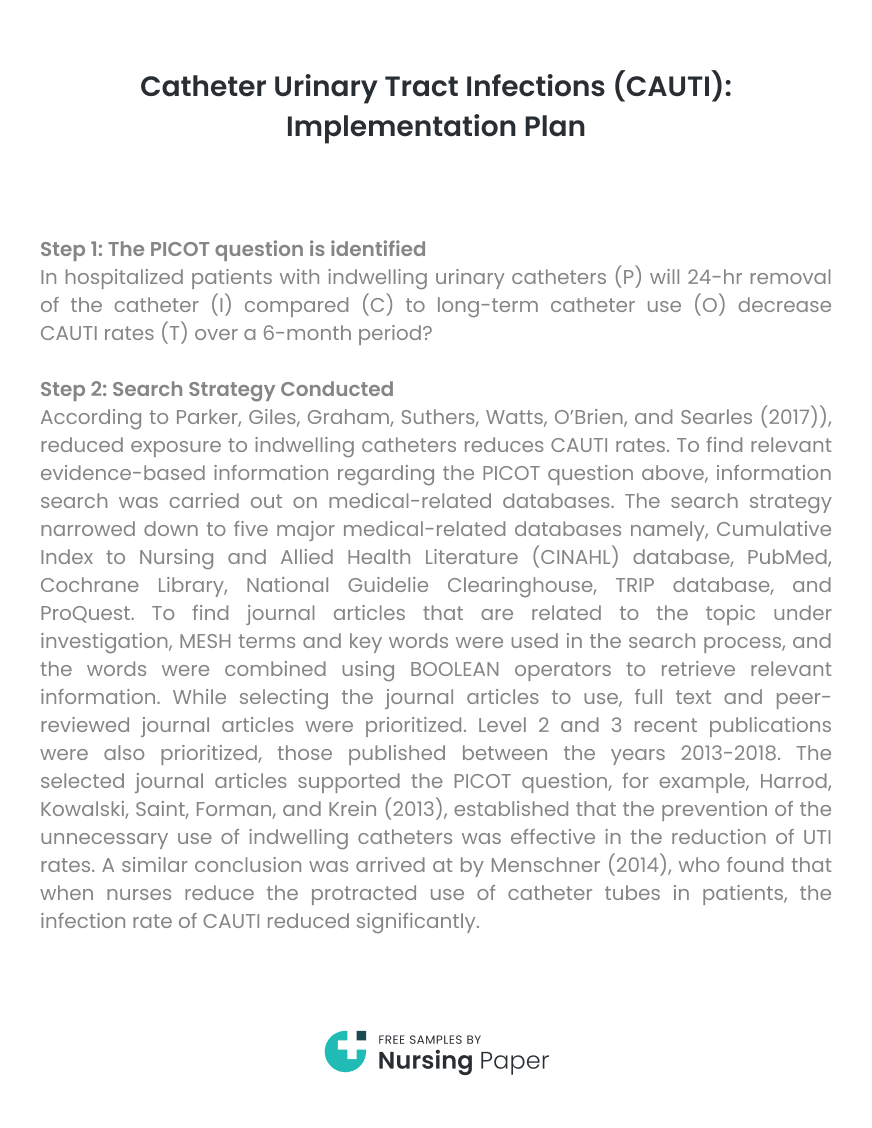
Catheter Urinary Tract Infections (CAUTI): Implementation Plan
Step 1: The PICOT Question is Identified
In hospitalized patients with indwelling urinary catheters (P) will 24-hr removal of the catheter (I) compared (C) to long-term catheter use (O) decrease CAUTI rates (T) over a 6-month period?
Step 2: Search Strategy Conducted
According to Parker, Giles, Graham, Suthers, Watts, O’Brien, and Searles (2017)), reduced exposure to indwelling catheters reduces CAUTI rates. To find relevant evidence-based information regarding the PICOT question above, information search was carried out on medical-related databases. The search strategy narrowed down to five major medical-related databases namely, Cumulative Index to Nursing and Allied Health Literature (CINAHL) database, PubMed, Cochrane Library, National Guidelie Clearinghouse, TRIP database, and ProQuest. To find journal articles that are related to the topic under investigation, MESH terms and key words were used in the search process, and the words were combined using BOOLEAN operators to retrieve relevant information. While selecting the journal articles to use, full text and peer-reviewed journal articles were prioritized. Level 2 and 3 recent publications were also prioritized, those published between the years 2013-2018. The selected journal articles supported the PICOT question, for example, Harrod, Kowalski, Saint, Forman, and Krein (2013), established that the prevention of the unnecessary use of indwelling catheters was effective in the reduction of UTI rates. A similar conclusion was arrived at by Menschner (2014), who found that when nurses reduce the protracted use of catheter tubes in patients, the infection rate of CAUTI reduced significantly.


Step 3: Critical Appraisal of Evidence
The evidence collected was critically appraised for internal and external reliability, validity, and applicability to the formulated PICOT question. To determine the reliability and the validity of the evidence collected, the tools used in the collection and analysis of data were evaluated. This criteria was also used in combination with the evidence level of the selected journal articles. The evidence appraisal was also based on the representativeness of the sample size that was used by the authors of the selected journal articles. For example, evidence with more than 50 participants were considered valid and reliable.
1. Harrod, M., Kowalski, C. P., Saint, S., Forman, J., & Krein, S. L. (2013). Variations in risk perceptions: a qualitative study of why unnecessary urinary catheter use continues to be problematic. BMC Health Services Research, 13(151), 1-12.
2. Menschner, E. (2014). Decrease Catheter Associated Urinary Tract Infections with Leader Rounding Using a Checklist. Drexel University.
3. Parker, V., Giles, M., Graham, L., Suthers, B., Watts, W., O’Brien, T., & Searles, A. (2017). Avoiding inappropriate urinary catheter use and catheter-associated urinary tract infection (CAUTI): a pre-post control intervention study. Health Services Research, 17(314), 1-10.



The download will start shortly.

The download will start shortly.
 Subject:
Health and Social Care
Subject:
Health and Social Care  Number of pages: 2
Number of pages: 2  Subject:
Nursing
Subject:
Nursing  Number of pages: 4
Number of pages: 4  Subject:
Health and Social Care
Subject:
Health and Social Care  Number of pages: 5
Number of pages: 5  Subject:
Medicine
Subject:
Medicine  Number of pages: 3
Number of pages: 3  Subject:
Nursing
Subject:
Nursing  Number of pages: 3
Number of pages: 3  Subject:
Health and Social Care
Subject:
Health and Social Care  Number of pages: 2
Number of pages: 2  Subject:
Medicine
Subject:
Medicine  Number of pages: 3
Number of pages: 3  Subject:
Medicine
Subject:
Medicine  Number of pages: 5
Number of pages: 5  Subject:
Health and Social Care
Subject:
Health and Social Care  Number of pages: 2
Number of pages: 2  Subject:
Medicine
Subject:
Medicine  Number of pages: 10
Number of pages: 10  Subject:
Nursing
Subject:
Nursing  Number of pages: 5
Number of pages: 5  Subject:
Medicine
Subject:
Medicine  Number of pages: 5
Number of pages: 5  Subject:
Medicine
Subject:
Medicine  Number of pages: 4
Number of pages: 4  Subject:
Health and Social Care
Subject:
Health and Social Care  Number of pages: 13
Number of pages: 13  Subject:
Health and Social Care
Subject:
Health and Social Care  Number of pages: 4
Number of pages: 4 
